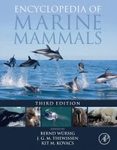About this book
Marine mammals attract human interest – sometimes this interest is benign or positive – whale watching, conservation programmes for whales, seals, otters, and efforts to clear beaches of marine debris are seen as proactive steps to support these animals. However, there are many forces operating to affect adversely the lives of whales, seals, manatees, otters and polar bears – and Marine Mammal Welfare explores how the welfare of marine mammals has been affected and how they have adapted, moved, responded and sometimes suffered as a result of the changing marine and human world around them. Marine mammal welfare addresses the welfare effects of marine debris, of human traffic in the oceans, of noise, of hunting, of whale watching and tourism, and of some of the less obvious impacts on marine mammals – on their social structures, on their behaviours and migration, and also of the effects on captivity for animals kept in zoos and aquaria. There is much to think and talk about – how do marine mammals respond in a world dramatically influenced by man, how are their social structures affected and how is their welfare impacted?
Contents
1. Preface
2. Introduction to marine mammal welfare
3. Cetacea - whales, dolphins, porpoises
3.1 The welfare effects of marine debris and fishery equipment on Cetacea, entanglement, toxicity - and of marine pollution including oil
3.2 Bycatch
3.3 Welfare impact of loss of habitat, changes in distribution and feeding and reproductive behaviours, and disturbances to migration
3.4 The welfare effects on Cetacean of human interactions - noise, boats, exploration, dredging, wind farms, whale watching, hunting
3.5 Noise in the ocean
3.5 Global climate effects on cetacean welfare
3.6 Social change in Cetacean populations resulting from human influences
3.7 Cetacea in captivity
3.8 Assessing the welfare of Cetacea - outcome based assessment methods in the wild and in captivity
4. Pinnipeds - seals, sea lions, fur seals, walrus
4.1 The welfare effects on Pinnipeds of marine debris and fisheries equipment, entanglement, toxicity - and of marine pollution including oil
4.2 Bycatch
4.3 Interactions with farmed fisheries
4.4 Welfare impacts of loss of habitat, human induced changes in distribution and feeding and reproductive behaviours, and disturbances to behaviours and social dynamics of Pinnipeds
4.5 The welfare effects on Pinnipeds of human interactions - tourism, hunting
4.6 Global climate effects on Pinniped welfare
4.7 Social change in Pinniped populations resulting from human influences
4.8 Pinnipeds in captivity
4.9 Assessing the welfare of Pinnipeds - in the wild and in captivity
5. Sirenia - dugongs and manatees
5.1 The welfare effects of human interactions on Manatees and Dugongs - boats, boat strikes, tourism, noise, the coastline as a recreational zone
5.2 The welfare effects on Sirenia of marine debris and fisheries equipment, entanglement, toxicity
5.3 Welfare impacts of loss of habitat, human induced changes in distribution and feeding and reproductive behaviours, and disturbances to behaviours and social dynamics of Sirenia
5.4 Social change in Sirenian populations resulting from human influences
5.5 Global climate effects on Sirenian welfare
5.6 Sirenia in captivity
5.7 Assessing the welfare of Sirenia - in the wild and in captivity
6. Ursidae - polar bears
6.1 The welfare effects of human interactions - human food and human waste, proximity to habitation, living together with polar bears
6.2 The welfare effects on Polar Bears of marine debris, fisheries equipment, entanglement, toxicity
6.3 Welfare impacts of loss of habitat, human induced changes in distribution and feeding and reproductive behaviours, and disturbances to behaviours and social dynamics of Polar Bears
6.4 Social change in Polar Bear populations resulting from human influences
6.5 Global climate effects on Polar Bear welfare
6.6 Hunting of Polar Bears
6.7 Polar Bears in captivity
6.8 Assessing the welfare of Polar Bears - in the wild and in captivity
7. Lutrinae - otters
7.1 The welfare effects of human interactions on otters - dogs, disturbance, fishing
7.2 The welfare effects on Otters of water borne debris, fisheries equipment, entanglement, toxicity
7.3 Welfare impacts of loss of habitat, human induced changes in distribution and feeding and reproductive behaviours, and disturbances to behaviours and social dynamics of Otters
7.4 Social change in Otters populations resulting from human influences
7.5 Global climate effects on Otter welfare
7.6 Hunting of Otters
7.7 Otters in captivity
7.8 Assessing the welfare of Otters - in the wild and in captivity
8. Conclusions
9. References
Customer Reviews
Biography
Dr Andy Butterworth MRCVS is Reader in Animal Science and Policy in the Clinical Veterinary School, University of Bristol, UK. Andy teaches and carries out research in the areas of animal disease and production, animal welfare and legislation, behavioural biology, and animal welfare assessment in both farm and wild animals. He is a member of the European Food Standards Agency Scientific Panel on Animal health and Welfare, and chairs the EEER (Ethics, Economics, Education and Regulation) of the Farm Animal Welfare committee in the UK. He lectures widely and publishes in books, and the academic and trade press, with over 200 publications to date.


























![Atlas des Mammifères Sauvages de France, Volume 1: Mammifères Marins [Atlas of Wild Mammals of France, Volume 1: Marine Mammals]](http://mediacdn.nhbs.com/jackets/jackets_resizer_medium/23/233077.jpg?height=150&width=108)


![Mexico Field Guides: Baja California - Sea of Cortez - Pacific Coast: Marine Mammals [English / Spanish]](http://mediacdn.nhbs.com/jackets/jackets_resizer_medium/13/139516.jpg?height=150&width=96)















